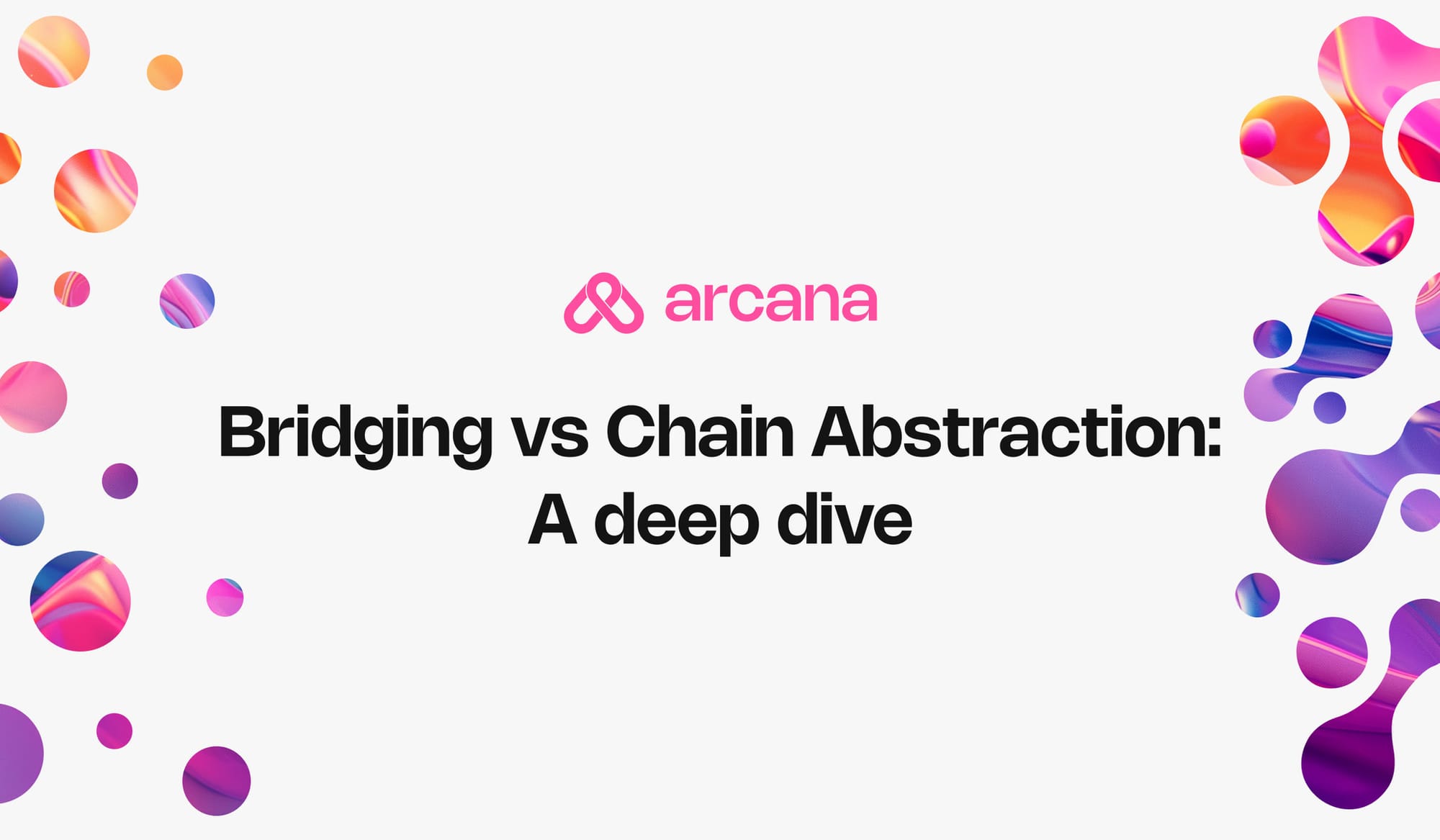Bridging Vs. Chain Abstraction: A Deep Dive
To fully appreciate how bridging and chain abstraction contribute to blockchain interoperability, it is essential to examine their key differences across several critical aspects.

Blockchain interoperability is key to a seamless Web3 future, where different chains and protocols communicate effortlessly. It enables blockchain networks to interact, share data, and transfer assets, unlocking each blockchain’s unique features and creating a more integrated, efficient space.
The need for interoperability became urgent as the number of blockchains grew. The current landscape is a patchwork of isolated networks, each with its own strengths. Harnessing these strengths simultaneously is a formidable task without interoperability. This fragmentation hampers innovation and widespread adoption, severely limiting the potential of blockchain technology.

Introducing Bridging And Chain Abstraction To Ease Interoperability
Bridging and Chain Abstraction emerged as two innovative solutions to address the need for interoperability. Bridging connects different blockchain networks, enabling them to communicate and share assets. This solution creates a link, or “bridge,” between two or more blockchains, allowing users to transfer tokens and data across these networks. The primary goal of bridging is to break down the barriers between blockchains, facilitating a more fluid and interconnected ecosystem.
Chain abstraction takes a different approach by simplifying the user experience and enhancing interoperability more fundamentally. Instead of merely connecting blockchains, chain abstraction abstracts away the complexities of interacting with multiple chains. It enables users and developers to work with blockchain networks through a unified interface, regardless of the underlying technology. This means users don’t need to understand the technical details of each blockchain they interact with; they can simply perform their desired actions, and the abstraction layer handles the rest.
Key Differences Comparison
To fully appreciate how bridging and chain abstraction contribute to blockchain interoperability, it is essential to examine their key differences across several critical aspects. Let’s compare bridging and chain abstraction in terms of security, user experience, technical implementation, performance, and use cases. By understanding these distinctions, we can better grasp the strengths and limitations of each solution and how they shape the future of the blockchain ecosystem.
- Technical Differences
When it comes to the technical implementation of bridging and chain abstraction, a key difference lies in their underlying models: push vs. pull.
Bridging operates on a push model. In this model, users are responsible for pushing information through the system. Users must manually select which bridge to use, specify the source and destination chains, select tokens, and manage the gas fees associated with the transactions. For example, suppose a user wants to transfer tokens from Ethereum to Binance Smart Chain. In that case, they need to initiate the transaction on Ethereum, specify the bridge to use, and then handle the token claim on Binance Smart Chain. This push model requires users to understand the involved chains and the bridging process, making it more complex and user-driven.
Chain Abstraction, on the other hand, leverages a pull model. Here, the system simplifies the process for the user by allowing them to specify only the destination chain and the desired actions. The abstraction layer then pulls the necessary details and manages the transaction. For instance, if a user wants to transfer assets, they just indicate the destination chain and the amount. The abstraction layer handles selecting the appropriate chains, managing gas fees, and executing the transaction through intents. This pull model abstracts away the technical complexities and reduces the number of steps users need to take, providing a more streamlined and intuitive experience.
The push model of bridging focuses on user control and customization but can be complex and time-consuming. In contrast, the pull model of chain abstraction emphasizes simplicity and user-friendliness, automating much of the process to enhance the overall experience. - Security Consideration
Security is critical when comparing bridging and chain abstraction, as both approaches have unique mechanisms to ensure safe and reliable cross-chain interactions.
Bridging involves transferring assets and data between blockchain networks. This process relies on validators or relayers to verify transactions and ensure their integrity across chains. While bridging can be secure, it introduces multiple points of vulnerability. For example, if a validator or relayer is compromised, it could lead to fraudulent transactions or asset losses. Additionally, bridges often rely on complex smart contracts and multi-signature schemes, which, if not properly audited, can be exploited by attackers. Historically, several bridges have been targets of significant hacks, highlighting the inherent risks of cross-chain transfers. About 70% of stolen crypto funds are hacked via bridges. Therefore, while bridging can be secure with robust mechanisms and rigorous audits, it is inherently susceptible to certain vulnerabilities.
Chain Abstraction: Security in chain abstraction is primarily centered around the abstraction layer and the relayers or intent handlers. Chain abstraction reduces the attack surface area by minimizing direct user interactions with multiple chains. Moreover, chain abstraction handles transactions through a unified interface, so it can incorporate comprehensive security protocols more effectively. However, the security of chain abstraction also depends on the robustness of the underlying infrastructure and the integrity of the relayers. Users here are at minimal risk because relayers or paymasters front the transaction, making it more secure for end users. Nonetheless, the security of chain abstraction is contingent on the strength of its implementation and the safeguards within the abstraction layer. - Performance and Efficiency
Performance and efficiency are crucial when comparing bridging and chain abstraction, as they directly impact the user experience and the overall functionality of cross-chain interactions.
Bridging can sometimes be hampered by performance bottlenecks. Users must manually initiate transactions, select appropriate bridges, and handle multiple steps, which can introduce delays. Additionally, bridges often require multiple confirmations from the source and destination chains, adding to the transaction latency. Network congestion on either chain can further exacerbate these delays, leading to longer wait times and higher transaction costs. The need for cross-chain validation and synchronization also contributes to inefficiencies, making bridging less performant in high-volume or high-demand scenarios.
Chain Abstraction generally offers better performance and efficiency by streamlining the process. Users only need to specify the destination chain and the desired action, and the abstraction layer takes care of the rest. This automation, added with a relayer or paymaster fronting the transaction, reduces the number of manual steps and time to finality. Solver networks handle transactions across multiple blockchains directly, dynamically finding the best transaction routes and potentially bypassing congested bridges.
Chain Abstraction also has a competitive fee market, allowing multiple entities, known as solvers, to compete to process transactions efficiently and affordably. Solvers optimize transaction paths across blockchains, considering fees and network conditions, which can differ from the fixed costs in traditional bridging.
In summary, while bridging can be effective, manual processes and network congestion often hinder its performance and efficiency. With its real-time optimization, competitive fee market, and streamlined approach, chain abstraction generally provides a faster and more cost-effective solution for cross-chain transactions. - User Experience
Up to this point in our discussion, you may have already grasped the user experience benefits of chain abstraction over traditional bridging. However, to fully appreciate the differences and advantages, let’s dive deeper into the specific user flows associated with each.
Bridging often presents a more complex and manual user experience. Users typically need to understand the specifics of the source and destination blockchains and the bridge they use. This process can involve multiple steps and waiting periods, which can be cumbersome, especially for those not technically inclined. Additionally, users need to know how to manage gas fees, adding to the complexity. While some bridges have improved their interfaces to streamline these steps, the inherent nature of the bridging still requires significant user involvement and understanding of cross-chain interactions.
Chain Abstraction, in contrast, aims to simplify the user experience by abstracting away the complexities of cross-chain operations. Users interact with a single, unified interface and have a unified balance that, in most cases, handles their underlying tasks. They simply express their intent, such as transferring assets or interacting with a dApp, and the abstraction layer takes care of the rest. This pull model eliminates the need for users to manually switch between chains, manage multiple wallets, or handle transaction confirmations on different networks.

As we look toward the future of blockchain interoperability, it becomes clear that bridging and chain abstraction have crucial roles, but their applications will diverge. Bridging will likely remain a critical B2B technology, serving as the backbone for rebalancing liquidity among relayers, paymasters, protocols, and other entities. Efficient liquidity distribution and strong partnerships with chain abstraction solutions and wallet-level integrations will determine the leading bridges in this space>
Conversely, chain abstraction is set to dominate the B2C space by simplifying user experiences and abstracting away the complexities of multiple blockchains. Consumers will benefit from seamless, intuitive interfaces, driving broader blockchain adoption. The most successful chain abstraction solutions will offer the best user experience and achieve wide distribution, becoming the go-to platform for everyday interactions.
In essence, while bridging and chain abstraction address the need for blockchain interoperability, they do so in complementary ways. Bridging will be essential for businesses, supporting cross-chain transactions and liquidity management, while chain abstraction will revolutionize the consumer experience, making blockchain technology more user-friendly. The winners in each category will excel through solid partnerships, superior UX, and broad distribution.
About Arcana Network
Arcana Network is building a modular L1 to power Chain Abstraction and intents, helping developers significantly improve user experience in Web3. Since 2021, we've introduced three groundbreaking products.
First up is Auth SDK, a decentralized social login to generate non-custodial Wallets. It is the fastest social login in web3, with a sub-3-second login time, and is free of cost. Games and consumer apps widely use auth SDK to simplify web3 user onboarding. Get a secure, in-app wallet, instantly, with no passwords or installations needed.
Next, Arcana Gasless is based on ERC-4337 Account Abstraction and enables developers to sponsor gas fees for users.
Our third product, SendIt, is a consumer app that redefines crypto payments by allowing users to send crypto to an email address, making transactions effortless and inclusive. SendIt has partnered with BNB and OKX.
Arcana has raised $4.5M from 40+ leading investors including Balaji S, Founders of Polygon, John Lilic, Santiago Roel, and funds like Woodstock, Republic, Fenbushi, Polygon ventures, DCG, and others.
Discover the Power of Chain Abstraction
Want to dive deeper into how chain abstraction can simplify your blockchain projects? Visit our Abstracted Academy and unlock the potential of seamless interoperability across chains.
Official Links: Website | Telegram | Twitter | GitHub | Discord

